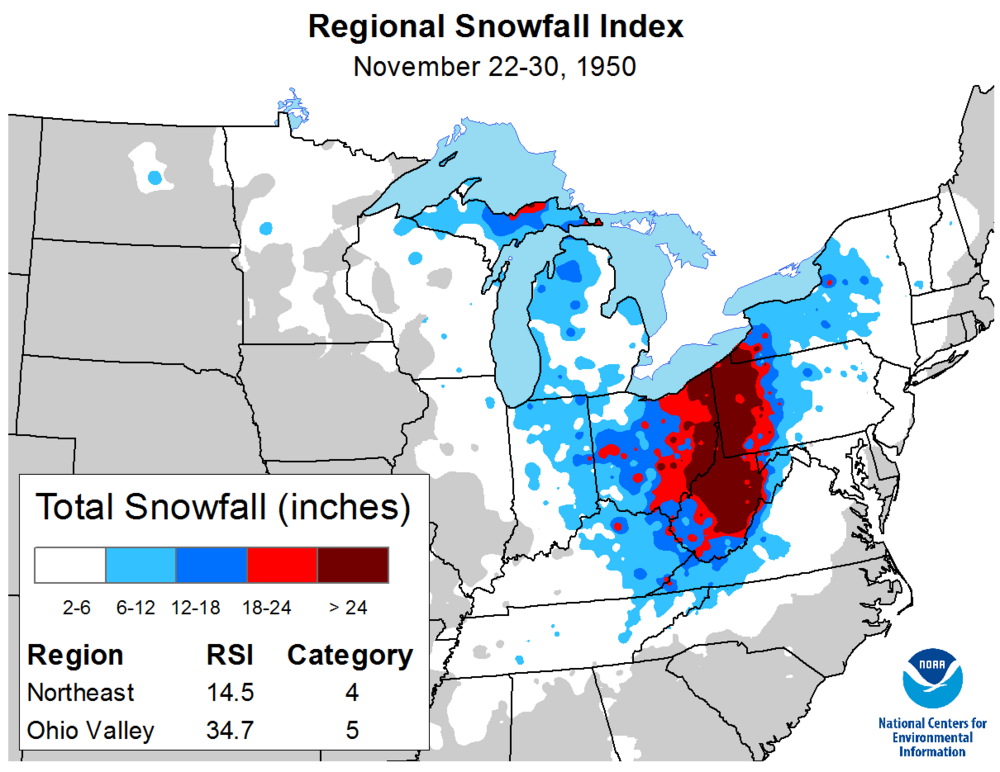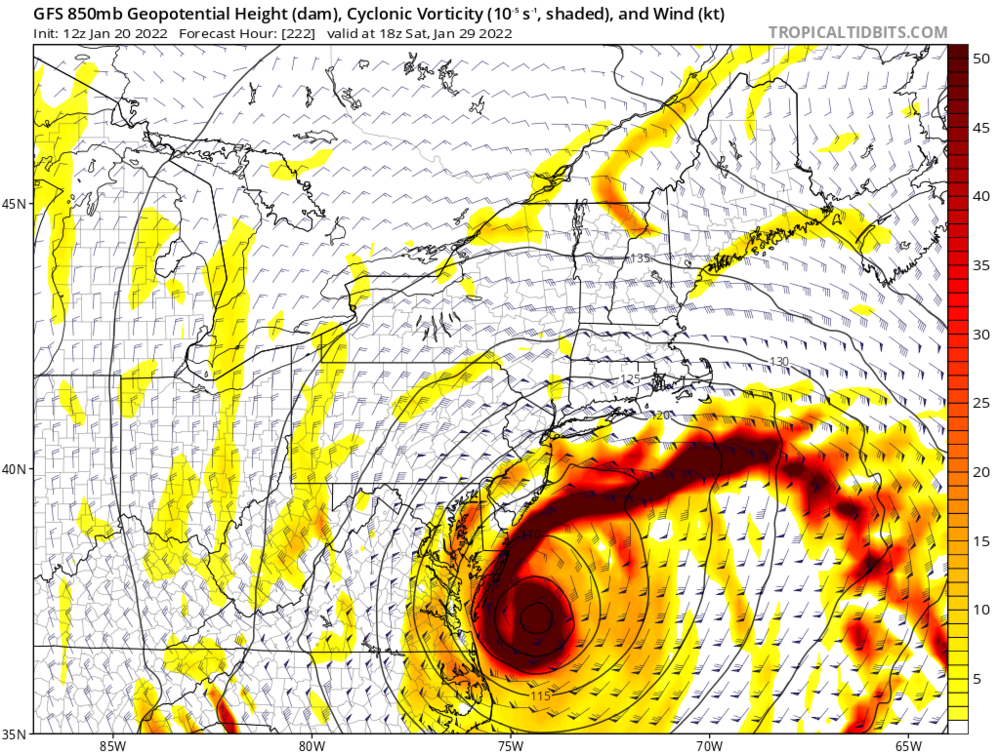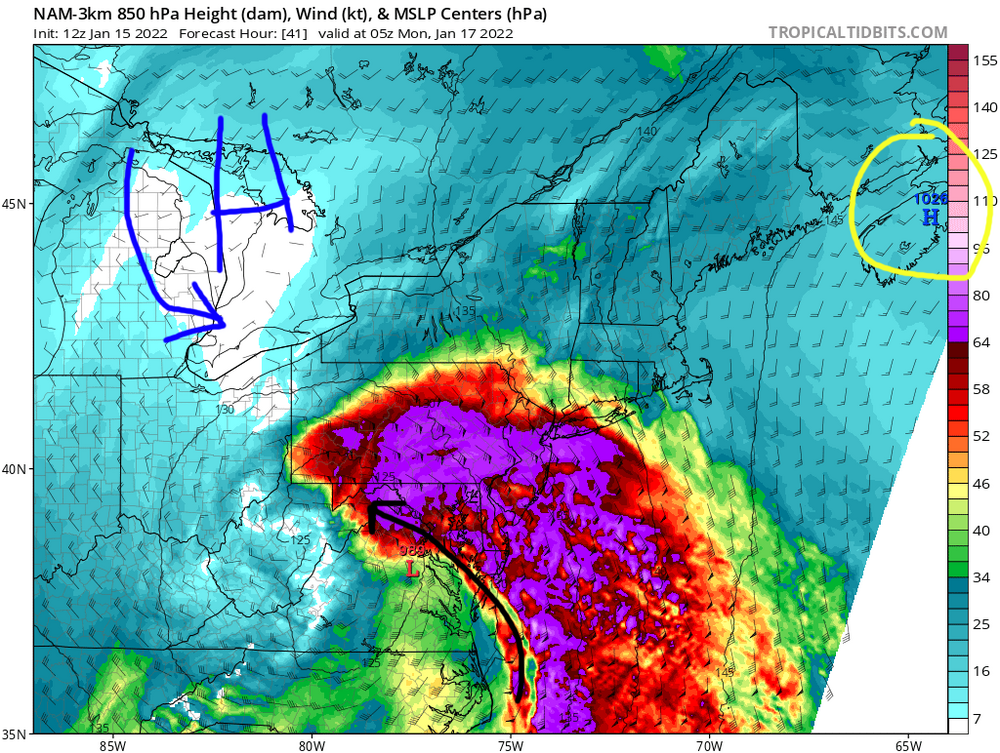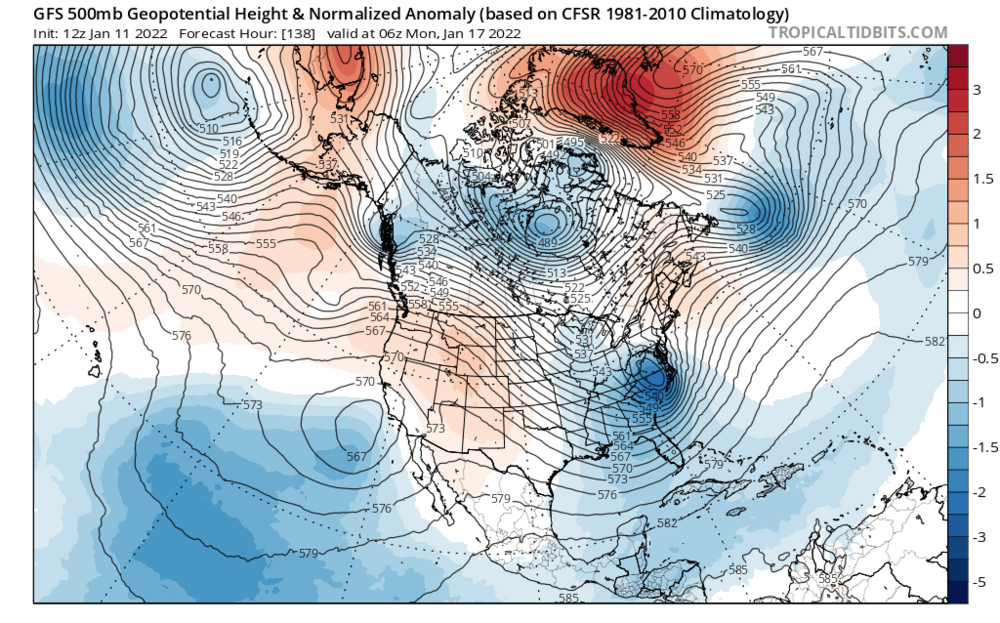-
Posts
1,146 -
Joined
-
Last visited
Content Type
Profiles
Blogs
Forums
American Weather
Media Demo
Store
Gallery
Posts posted by jwilson
-
-
5 minutes ago, jhotdog said:
Any thoughts on when the harder stuff will be moving into bucks and Montco guys?
Looks like between 11 PM and 1 AM, from south to north. Assuming it maintains a somewhat north-NE trajectory.
-
7 minutes ago, kpantz said:
SREF plumes for total snow have gone up in E PA (KABE) if you compare 21Z to 15Z. Seems to be something else on which to hang ultimately dashed hopes.

I was just looking at those myself. Rooting for you guys to score; one SREF member has 30" for PHL. Better ride that one! Mean is 8.31" in Philly. That's almost double the previous run.
-
Tracking stuff like this is enough to make you miss El Nino winters with southern-stream dominant precip bombs, even if it means rain. These NS systems are so bipolar.
-
2 hours ago, Rd9108 said:
I appreciate your analysis and wisdom but you crush weenies hearts lol.
Haha, I promise it's not intentional. I try to be realistic about things.
Ironically, the 18Z GFS got really close to the NAM solution and continued the trend from the previous two runs. There are still very subtle differences, with the ridge being slightly steeper and elevated on the NAM, while the GFS wants to tamp it down some. The trough is also broader on the GFS than the NAM, which seems to push the surface low development just slightly off to the east and north. We're talking OBX versus Cape Fear, a pretty minimal variation. Both genesis the low off Jacksonville, FL. The GFS wants that rapid NE movement, though.
I guess this is where I have a knowledge gap because I honestly don't understand that surface depiction from the GFS. To me, the energy is actually even better consolidated than it was at 6Z Monday, which was the tightest coastal solution the GFS has shown of late. If you compare the trough between the two, the 18Z run today has dug fairly significantly further south. The 540 line is over Huntsville, AL as opposed to Bowling Green, KY. Especially if you saw these two runs side-by-side, you'd look at the 500H today and almost certainly think, "that's turning the corner and would be the better outcome."
But it doesn't. I'm having trouble understanding why. Maybe the ridge out west being just a little flatter above Boise is enough? Is the 850 low too far to the east and needs captured? For now those are my only theories. The way it looks at 500, I think, would result in some more northward pull, unless that 850 gets off the coast and moves everything with it?
-
19 minutes ago, dj3 said:
I would definitely take some early overrunning snows as the low deepens offshore, even if we miss the wrap-up.
That said, it's a classic 84-hour NAM signature. Must be part of its programming. At 0Z I'll expect this to be 250 miles offshore and much drier.
-
I'm shocked people are trusting the Euro to get this right. It's been beaten consistently by the GFS over the last month.
There were two runs yesterday where it looked like you might get consistency, only for the models to immediately relent on the phasing and make it a Nantucket special. The setup remains quite precarious, with a delicate phase required to get anyone south of Boston into the snow. That's likely why you'd have to favor it not happening.
That said, the trends over the last three runs have been to pull in that southern energy more and more leading to an earlier phase, rather than leave the energy elongated and lagged in the west. The differences in 12Z from yesterday to today are quite subtle: more shallow ridge out west and a trough that's a bit too neutral and open. The Canadian solutions are a little more obviously contrasted, but the 12Z run from yesterday for that was an extreme solution and always unlikely.
I would ride the GFS for this one and unless it goes back to an earlier phase and a steeper ridge position, it's probably game over outside of coastal New England.
-
 1
1
-
-
-
It's way too soon to talk details on this, but next weekend's event - as currently depicted on all the models - looks somewhat similar to the one earlier this month. A northern-stream s/w dives below the trough and amplifies in the southern states. Due to the early cut-off and bombogenesis, chances are higher than normal that this storm would ride a similar path up along the Appalachian trail. However, the GFS attempts a solution where another piece of energy in the NS acts as a kicker/barrier. The Canadian slows down the event by phasing a more substantial piece of southern-stream energy with the northern, and instead of being a kicker, that lagged or second piece of energy acts as a fuse.
Unsurprisingly, the CMC version of events gets pulled further west and would potentially be a bigger hit to our area. It could also be too much of a good thing like the last storm, and with no confluence up top, it would get pulled too far west resulting in another messy solution. The GFS timing might miss our area altogether and ride the coast.
The Euro also shows a storm that's probably closer to the GFS in timing/evolution but is more an inland runner. 3/3 at this lead-time is unusual, so there's little doubt it's something to put in the back of your mind for now. I do notice that none of them show a traditional block or high-pressure placement as seems to be the trend lately. For now it's not a big deal, but an important detail later.
The questions will come down to timing, wave spacing, confluence, and how much (if any) southern-stream involvement.
-
 2
2
-
-
-
2 hours ago, RitualOfTheTrout said:
THIS. I was going to post, good news is there a several s/w so plenty of chances for something to pop, bad news, there are several s/w so models will have a hard time figuring out which ones to focus on and they will in some cases interfere with each other. I'd fully expect in this setup something might just blow up in the short / medium term. If a storm is going to miss us, we probably want it to stay weak and progressive and get the hell out of the way so as to not interfere with the next one with spacing issues etc.
Agreed. I think this current week is too noisy for any one storm to really explode. Everything else is running interference and taking away some of the potential energy. Not long after my other post, the Euro - at 12Z - went towards the GFS solution. There's definitely still time to resolve it, either way, but I have low confidence in something for this week. The clipper overnight Monday into Tuesday is perhaps our best next chance for snow. Pretty standard 2-4" deal.
There's a number of systems getting blown up in the long-term, but none of that is reliable right now. Unless a window clears again where there's a single piece or two of energy that can time together and phase. The GFS keeps hinting at it in the long-term, again at 18Z around hr. 240, but it's hard to take those threats seriously.
-
While the Euro has better verification scores at 5+ days, the GFS nailed the last storm at about 140 hours and led the way. What does that mean for the upcoming system?
We're approaching 100 hours, give or take, on this next one and the GFS still shows a strung-out solution. The CMC has waffled a little, but a few runs in a row now consistently have shown a slider. The last big solution there was 0Z Sunday.
Looking at the lead-up, there are four main pieces of energy at 500H. The GFS is half-heartedly trying to phase two of them in the east, but a piece behind in the NS kicks the other northern energy out and too much is held back in the southwest as a cutoff.
It's really a mess and probably could be considered too much of a good thing (as in too many s/w moving around the CONUS).
But if you go back and look at the last storm, it was basically the only piece of energy in the CONUS at the time, excepting the smaller piece in the NS that dove down and helped sharpen the trough behind our main system. In that sense, the setup was much simpler. The GFS keyed on that and blew it up. The next system has to deal with much more movement across the country and a few more pieces of energy to calculate. There's also more southern stream involvement.
For now I'm not sure the models can really handle what's happening at the upper levels. It's a complex arrangement and even though the GFS nailed the last storm, it may not be handling this setup as well. Unless the Euro gets some support by Thursday, however, it's going to be tough to buy anything for the weekend. Assuming the Euro would stick to its current solution, of course.
-
In the end, 6-12" ended up being the right call. We didn't hit the maxima in terms of potential, but all the warning signs were there. Sleet and wind cut down on ratios and snow growth. As I stated a couple days ago, we needed that reinforcement shot of cold air to keep the 850s from roasting. We just didn't have the proper placement of high pressure to prevent it. I'd have to double check but I imagine the upper level low also gained more latitude than modeled.
-
I think 6-12" is a fine call for now. There's a slight chance it overperforms locally, but this isn't the most congealed looking precip shield currently and thus accounting for potential threats to the maximum potential. On a "bust scale" of 1 to 10, I'd probably put this at a 7. It isn't the cleanest looking setup. However, in our relatively snow-starved climate for big ones, we take a double-digit potential any day even if it comes with caveats.
Hope for the best as we watch it roll in.
-
We can see the problem quite evident on the NAM (among other high-res models):
Off to the northeast (circled in yellow) is the retreating high pressure. It's also not particularly strong. The high pressure I've added (to the northwest) is what we really would prefer to see in this situation, or at least due north in southern Quebec. Unfortunately, that doesn't exist. It would act to reinforce the cold air and provide some resistance to counter warm ocean flow in the mid levels. It could also limit the latitude gains by the low pressure(s).
The NAM is definitely the strongest with this easterly fetch feature, but the RGEM is close there, too. The other problem is the dryslot, and if the precip cuts off, that would allow for more warm air to seep into the equation.
Now I can't say for sure if the NAM is right on this, and I'm not an expert so I defer to those that are. However, I'm personally hesitant when I see these features creeping up on the short-term. This storm definitely has a high bust potential for someone, while for someone else it might over-deliver. The question simply becomes who is left with each of those outcomes. We've also seen, when there's little resistance upslope, captured lows get pulled further to the north than expected. Not that it's guaranteed here, but another possible observation.
It really will come down to nowcasting. No model is going to have this exactly right.
-
 1
1
-
-
3 hours ago, Ahoff said:
Is RGEM a good model?
Not at the end of its envelope. Better to wait, like the NAM, until it's in a more usable range (24-48 hours).
-
 1
1
-
-
39 minutes ago, Mailman said:
Personally, I am rooting for the 18z RGEM solution to verify.
RGEM puts down about 10" in 7 hours, give or take. If that precip shield maintained integrity, with another six to eight hours of snow, you'd be approaching the two foot mark. The frontogenic forcing is off the charts. Certainly fun to look at.
Whomever gets under the CCB in this will definitely win big. Think back to last December and that's why many places in the PIT area hit close to a foot.
-
This is the kind of storm the mesoscale models were made for. I'm waiting for that 36-hour NAM range. I will say the operationals from the big three have been remarkably consistent since Tuesday. For a 5/6 day lead that's quite impressive, especially with such a complex system. Although we also know it's much harder to get an east trend than it is a west trend.
-
34 minutes ago, Rd9108 said:
ICON is east of its 12z run fwiw
I know people use the ICON as an additional resource, but I really don't think the model has much value.
That said, this storm becoming a Central PA special is definitely not out of the question. Unfortunately, if it becomes a stacked and occluded low, you're going to have a tight bowling-ball precip shield. To get the best snowfall then you'd have to be on the western border of the central LP with not much room for error. Obviously the exact track is still waffling, but you get this scenario and move the low back east away from us and suddenly PIT's potential goes from 8-12" to 2-4" or the like. It's not a normal Miller A with expansive overrunning.
The ensembles appear to keep lagging behind the operationals. If the operationals start jumping east, watch for the ensembles to catch up in a couple cycles. TBD.
-
12Z nudged east just slightly, which at least ends the northwest trend. For now that's good.
The snowfall maps are wonky but don't worry about those too much. The GFS is generally poor at mesoscale features and placement. This system looks to have some intense frontogenic forcing and deform banding. I also don't think this storm has that high-end of a potential. 8-12" is probably the appropriate ceiling. It's not a 24-hour storm, which is what we need to see those historic numbers. The bulk of the snow is done in 12 hours, give or take.
-
We actually need that west trend to stop. The GFS keeps amplifying the energy dipping down immediately behind the main system and it's sharpening the trough, which in turn pulls the main low more to the west. We're now at the point where the lows are almost triple-stacked and pass right over Western PA. That's danger territory if it moves any further. We also see the high pressure scoured out to the east without much resistance.
6Z yesterday was the last time the GFS showed a true coastal.
-
It's a very unusual looking evolution. Pure northern stream that digs down and tries to imitate a Miller A. This is basically an Alberta clipper that is going as March of '93 for Halloween.
The timing looks better than it did on previous runs, but this is a window I've been looking at for a while now.
You can see here the -NAO starting to really pump above Greenland and the 50/50 off Newfoundland. Ridge out west. Closed off low near the benchmark. This is about as classic of an East Coast snowstorm look as you can get on paper. The fine details still need to work themselves out as all these pieces of energy rotate around the trough. Someone in the east is probably going to get buried, however. Could be anywhere.
-
 2
2
-
-
Nothing hugely exciting with this event, but when it's early in the game and you just need points, you take the field goal.
The week ahead looks relatively quiet, I think. We're still transitioning from the older pattern to a new regime that favors east coast troughing. Absent something else that pops up, of course, perhaps a clipper or surprise s/w.
The week after is when things start to get interesting. The CMC and GFS both have "big dog" signals on them in the longer range. Their evolution isn't the same, but they depict fairly typical major storm scenarios. Granted, for now you take it with a grain of salt, but they've been hinting at this for days now. Stand-out events like that can be sniffed out early, albeit rare. Last one was 2016.
A period to watch, for sure. Hopefully we can score something with the unexpected STJ involvement. We may also have to score this month if the pattern reverses and spring starts in February.
-
I think the new period to watch is from the 16th to the 23rd. The PNA has relaxed and we have a possible +spike incoming around that time period. I wasn't sure if a true pattern change would happen but it's clearly in process. If January ends up cold over the latter half, it might offer multiple chances to overcome our current deficit. The question would be whether the warmth reloads in February or if a weakening Nina means we don't get shut out totally.
We might also be trending toward another -NAO and a -AO. Again, still somewhat dependent on long-term solutions that aren't always predictable, but there are good odds that a -NAO in December means the same block returns later in winter. Even if we were to get everything in one go, we do need some blocking to slow down this flow.
-
 1
1
-
-
Latest GFS wants to start squashing things again. Not enough separation of the two waves. You really want the first wave to speed up and move out of the way or the second wave to lag behind, getting enough space to start tilting towards the negative before it jumps off the coast. Miller B systems don't generally work in PIT unless the first primary has time to strengthen.
I don't trust the long-range NAM so while it looks better, I don't think it's enough to consider beyond a brief note.









January 28th/29th Event Obs - From KU to FU?
in Philadelphia Region
Posted
Anyone down in Dover? They must have a nice pile already, right under all that confluence.